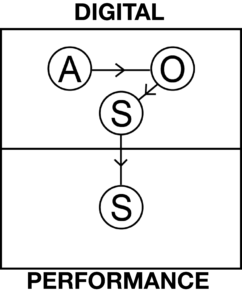Connecting each element (S, O, A, and P) are lines with arrows denoting the progression of influence from one to the next. In this example, I will use the diagram for my composition, Lines.[29]

Here, we can see the progression in the digital environment from agency to objects to space before the sound travels into the performance environment by means of loudspeakers. Once in the performance environment, the sound is once again altered by the acoustics and relative placement of the speakers to the listener before the sound is heard.
The justification for the progression is this: whilst the term objects represents the sounds themselves, an agent has first had to act in order to create that sound. The sound in this example is a ping pong ball in a glass vessel and the action of letting the ball drop must have come first in order for the sound to happen.
Whilst I have chosen this progression, I must acknowledge that some might argue in favour of placing objects before agency. This is because the listener first hears the sound and then, based on their experience of that sound, will imagine an agent accordingly. This is how the sounds are immediately perceived. I do not, however, believe this to be the best way to organise these elements. This is because the listener, with their experience of the real world, will understand that the action has happened before the sound; they hear the sound, perceive an agent, and then proceed to understand the sound object as an action that led to a sound.
Space is the last aspect of the digital environment through a similar thought process. As space represents the acoustics of a location (either real or imagined) and the orientation of the listener in reference to this sound, we understand that the sound is produced first and then is subjected to transformation based on the acoustics and listener orientation. Similarly, we first need to hear the sound in order to gather spatial information, however, the listener, once having gathered this information, will still be able to understand the progression as objects that happen first and then travel through a space.
Once all the influences of the digital environment are accounted for, the sound then travels through the speakers into the performance environment. There is influence from the acoustics of the venue and the orientation of the listener to the speakers before the sound waves reach the listener’s ears.
The diagrams are structured to reflect the true order of occurrence rather than the order of immediate perception. This is because immediate perception is fleeting but the information gathered by it leads to the listener understanding the true order of occurrence.
[16]All of my portfolio compositions are discussed at greater length in section 3 of this commentary.
